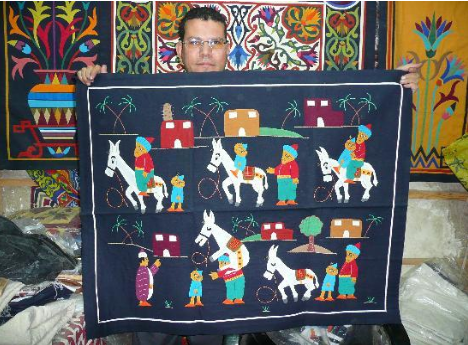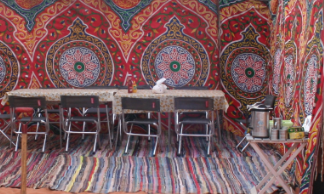Take a stroll with me down the Chareh el Khiamiah, or “street of the tentmakers.” Found in the heart of Old Islamic Cairo, it is the only place where the street is still covered as in days of old. The sun fights its way through the openings in the roofs, casting patterns of light and color across the narrow street.
 Illuminated by the patchwork of the sun’s rays, more than 40 shops glow in brilliant colors moving with the heartbeat of the street. Geometric designs fill the space with the ease and beauty of the master artist’s hands on canvas. It’s tough to separate the patterns of light from the appliqué artwork adorning this sea of color and life.
Illuminated by the patchwork of the sun’s rays, more than 40 shops glow in brilliant colors moving with the heartbeat of the street. Geometric designs fill the space with the ease and beauty of the master artist’s hands on canvas. It’s tough to separate the patterns of light from the appliqué artwork adorning this sea of color and life.
Like a colorful background, the rhythm of the street creates a feast for the senses in sight and sound. This is where we find the Tentmakers of Cairo.
Stepping into one of the shops, my mind is a flurry of activity. I’m in awe of the stunning work covering every inch of the walls. I feel the need to be silent, reverent even, like I’ve walked into one of the great European Cathedrals. Yet, there are no marble statues; I’m met by the smiling face of the master artist busily at work. Without missing a stitch, Hosam greets me with the joy of an old friend, even offering me some tea.
 Hosam remains in his spot with a welcoming smile, eagerly watching my reactions to each work of art. The fabric designs are so alive they may escape from their canvas-backed medium, only to be held in place by Hosam’s precision appliquéd stitching. I get lost in the quilts for some time, and snap back to reality to see a master craftsman stitching quickly to capture another creature in the cotton landscape.
Hosam remains in his spot with a welcoming smile, eagerly watching my reactions to each work of art. The fabric designs are so alive they may escape from their canvas-backed medium, only to be held in place by Hosam’s precision appliquéd stitching. I get lost in the quilts for some time, and snap back to reality to see a master craftsman stitching quickly to capture another creature in the cotton landscape.
Part craftsman and part proprietor, Hosam is also an artistic master. Unlike many of the older generation, he is not content creating quilts of the same patterns his father taught him. Instead, he imagines the shapes, creatures, and designs that form his works of art. Sometimes he may express emotion through variations on traditional shapes and designs; other times he captures a scene from the storyboard of his imagination. Watching him combine this artistic vision with the skill of transferring designs from paper to fabric is awe-inspiring.
Hosam and the other tentmakers rely on the sales of their quilts to support families. Yet two unfortunate realities are pressing against them and threaten to crush this ancient art.
 The quilts on the Shariya Khayamiya aren’t typical quilts like we’ve come to expect. Instead, they are canvas-backed cotton with brilliantly colored appliqué meant to hang upright. In the times of nomadic desert travel, homes were constructed of canvas walls and roofs. Tentmakers began embellishing the inner walls with brightly colored designs, perhaps to bring color and texture to the spartan desert landscape.
The quilts on the Shariya Khayamiya aren’t typical quilts like we’ve come to expect. Instead, they are canvas-backed cotton with brilliantly colored appliqué meant to hang upright. In the times of nomadic desert travel, homes were constructed of canvas walls and roofs. Tentmakers began embellishing the inner walls with brightly colored designs, perhaps to bring color and texture to the spartan desert landscape.
With the typical creativity and ingenuity expected from the culture responsible for the Pyramids, these designs became more vibrant, more intricate and more beautiful. What was once the utilitarian work of laborers is now one of the most amazing forms of art in Egypt. Yet, because of their useful and ancient origins, many in Egypt no longer value the work of the tentmakers.
While the use of the quilts as dwellings has fallen aside, there are still ceremonial purposes. The brilliantly colored appliqué are still used for temporary decorations at weddings, funerals, henna parties, or Ramadan celebrations. However, some people are now copying the designs of the tentmakers, turning them into preprinted synthetic panels. These low cost, weak imitations are yanking the rug from under the tentmakers’ business.
Outside of Egypt, there is a growing demand for their beautiful and colorful appliqués. This international interest is helping to keep the few remaining tentmakers in business. These artistic pieces made their debut in the United States at the AQS Quilt Show & Contest in Grand Rapids Michigan, on August 22-25, 2012, to stellar reviews.